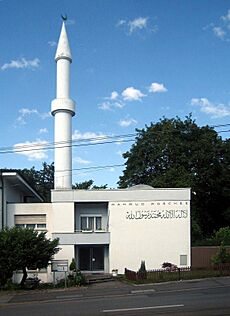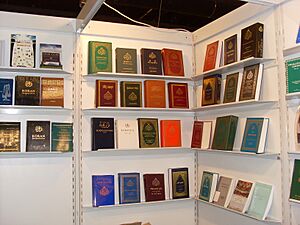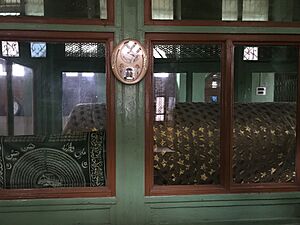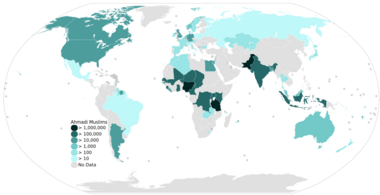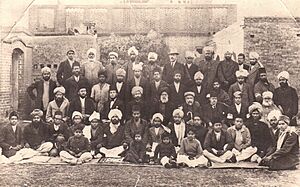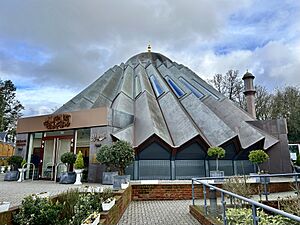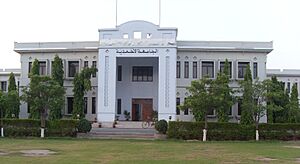Ahmadiyya facts for kids
Quick facts for kids Ahmadiyya Muslim CommunityAhmadiyya Muslim Jama'at |
|
|---|---|

The White Minaret and the Ahmadiyya flag in Qadian, India. For Ahmadi Muslims, the two symbolize the advent of the Mirza Ghulam Ahmad.
|
|
| Type | Sect of Islam |
| Scripture | Quran and various books of Mirza Ghulam Ahmad |
| Caliph | Mirza Masroor Ahmad |
| Founder | Mirza Ghulam Ahmad |
| Origin | 19th century British India |
| Separated from | Sunni Islam |
| Number of followers | 10–20 million |
The Ahmadiyya Muslim Community is a religious movement that started in British India in the late 1800s. It was founded by Mirza Ghulam Ahmad (1835–1908). He believed he was chosen by God to be the Promised Mahdi (a guided leader) and Messiah. Muslims expected these figures to appear near the end of time to bring peace and help Islam succeed.
Ahmadi Muslims believe that Islam is the final and perfect religion for everyone. They think it needs to be brought back to its original, pure form. They see Mirza Ghulam Ahmad as the Mahdi who came to refresh Islam. He taught what they believe are Islam's first rules, just as Muhammad and his early followers practiced them. Ahmadis believe they are helping to spread and renew Islam around the world.
Mirza Ghulam Ahmad officially started the Community on March 23, 1889. Since his death, leaders called Caliphs have guided the Community. By 2017, it had grown to 210 countries. Many Ahmadis live in South Asia, West Africa, East Africa, and Indonesia. Ahmadis are known for their missionary work. They were the first Muslim missionary group to arrive in Britain and other Western countries. Today, the Community is led by its Caliph, Mirza Masroor Ahmad. It has an estimated 10 to 20 million followers worldwide.
The Ahmadiyya movement is mostly one large, organized group. However, a small group called the Lahore Ahmadiyya Movement formed early on. They had different ideas about Mirza Ghulam Ahmad's role. Many other Muslims consider Ahmadis' belief in Mirza Ghulam Ahmad as a prophet to be against mainstream Islamic teachings. This is because most Muslims believe Muhammad was the final prophet. Because of this, Ahmadis have faced persecution in many places. Some Muslims use the term Qādiyānī to refer to them, which Ahmadis do not use for themselves.
Choosing the Name
The Ahmadiyya movement began in 1889. However, the name Ahmadiyya was chosen about ten years later. In 1900, Mirza Ghulam Ahmad announced that the movement would be named after Muhammad's other name, Ahmad.
He explained that the name Muhammad means "the most praised one." This name showed the glory and success of the Islamic prophet after he moved to Medina. But Ahmad means "highly praised" and "one who praises the most." This name showed the beauty of his teachings and the patience he showed earlier in Mecca. These two names, he said, showed two sides of Islam. The "Ahmad" side was meant to be important for Islam's progress later on.
Mirza Ghulam Ahmad believed it was wrong to name an Islamic group after anyone other than Muhammad. So, in 1900, he stated that the best name for his movement was "Muslims of the Ahmadiyya Section."
What the Name Means
The word Ahmadiyya refers to the movement itself. The word Ahmadi refers to a follower of the movement. Ahmadis say the name comes from Islamic prophecy and Muhammad's name, not from their founder. However, some Sunni Muslims, especially in the Indian subcontinent, call Ahmadis Qādiyānī or Mirzaī. These names come from Qadian, Mirza Ghulam Ahmad's hometown, or from his title Mirza. Ahmadis never use these names for themselves.
History of the Ahmadiyya Community
| Ahmadiyya Timeline
|
|
|---|---|
| 1882 | Mirza Ghulam Ahmad privately says he is the Reformer of the 14th Islamic century
|
| 1889 | Mirza Ghulam Ahmad starts the Ahmadiyya Muslim movement
|
| 1890 | Mirza Ghulam Ahmad announces he is 'The Promised Messiah' and 'The Imam Mahdi'
|
| 1908 | Mirza Ghulam Ahmad dies. Hakeem Noor-ud-Din becomes the First Caliph
|
| 1914 | Mirza Basheer-ud-Din Mahmood Ahmad becomes the Second Caliph
|
| 1947 | Mirza Basheer-ud-Din Mahmood Ahmad moves to Lahore, Pakistan
|
| 1948 | Mirza Basheer-ud-Din Mahmood Ahmad creates Rabwah as the new headquarters
|
| 1965 | Mirza Nasir Ahmad becomes the Third Caliph
|
| 1982 | Mirza Tahir Ahmad becomes the Fourth Caliph
|
| 1984 | Mirza Tahir Ahmad moves the headquarters to London, England
|
| 2003 | Mirza Masroor Ahmad becomes the Fifth Caliph
|
| 2019 | The headquarters moves from Fazl Mosque in London to Islamabad in Tilford, Surrey
|

The Ahmadiyya Muslim Community officially began on March 23, 1889. This is when Mirza Ghulam Ahmad accepted promises of loyalty from his followers in Ludhiana, India. However, the story of the Community can be traced back to Ahmad's early life. He reported receiving messages about his future role.
In the late 1800s, Mirza Ghulam Ahmad of Qadian announced that he was the "Centennial Reformer of Islam." He also said he was the second coming of Jesus and the Mahdi that Muslims were waiting for. He gained many followers, especially in certain regions of India. Ahmadis believe that Muhammad and other religious scriptures predicted his arrival. The Ahmadiyya movement started in India partly in response to Christian and Arya Samaj missionary work happening at that time.
Ahmadis believe their faith is a modern revival of Islam. They began organized missionary work overseas as early as 1913. For many countries, the Ahmadiyya movement was their first contact with Muslims. Today, the Ahmadiyya Muslim Community has one of the most active missionary programs globally. It is especially large in Africa. After colonial rule ended, the Community helped spread Islam across the continent.
First Caliphate
After Mirza Ghulam Ahmad passed away, Hakeem Noor-ud-Din was chosen as his first successor and Caliph. During his six-year leadership (1908–1914), he oversaw an English translation of the Quran. He also established the first Ahmadiyya Muslim mission in England. He started various newspapers and magazines for the Community. He also created an official treasury to manage the Community's growing finances.
Second Caliphate
After the first Caliph's death, Mirza Basheer-ud-Din Mahmood Ahmad was chosen as the second Caliph. However, some members, led by Maulana Muhammad Ali, disagreed with this choice. They formed the Lahore Ahmadiyya Movement. This split happened because they had different beliefs about Mirza Ghulam Ahmad's role as a prophet and how the leadership should continue. The Lahore Ahmadiyya movement has remained much smaller.
Mahmood Ahmad was elected at a young age. His leadership lasted for almost 52 years (1914–1965). He created the Community's organizational structure. He also guided extensive missionary work outside India. He launched two programs, Tehrik-e-Jadid and Waqf-e-Jadid. These programs encouraged members to give their time and money to their faith. These efforts produced many books defending Islam and Ahmadiyya beliefs. Funds also helped train and send Ahmadi missionaries around the world.
During his time, missions were set up in 46 countries. Mosques were built in many foreign lands, and the Quran was published in several major languages. Mahmood Ahmad wrote many books, including a ten-volume commentary on the Quran.
Third Caliphate
Mirza Nasir Ahmad became the third Caliph on November 8, 1965. His leadership lasted until 1982. He continued to expand missionary work, especially in Africa. He guided the Community when the National Assembly of Pakistan declared Ahmadis a non-Muslim minority. After his 1970 trip to West Africa, he started the Nusrat Jahan Scheme. This program built many medical clinics and schools in Africa. During a visit to Spain for the first mosque there, he created the famous Ahmadiyya motto: Love for all, Hatred for None.
Mirza Nasir Ahmad also established the Fazl-e-Umar Foundation. He oversaw the collection of Mirza Ghulam Ahmad's sayings and writings. He also directed the full collection of the founder's dreams, visions, and revelations.
Fourth Caliphate
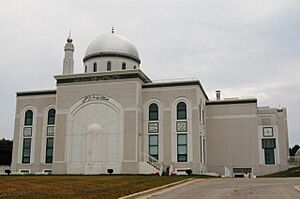
Mirza Tahir Ahmad was chosen as the fourth Caliph on June 10, 1982. He remained Caliph until his death in 2003. In 1984, the government of Pakistan issued a law that made it hard for the Caliph to do his duties. Because of this, Ahmad moved from Pakistan to London, England. The Community's headquarters moved to Fazl Mosque in London. For Ahmadis, this move marked a new time for the Community.
Ahmad launched the first Muslim satellite television network, Muslim Television Ahmadiyya. He also started the Waqfe Nau Scheme. This program encourages Ahmadi Muslim children to dedicate their lives to serving the Community. He also created funds for helping people, like the Maryum Shaadi Fund and the Syedna Bilal Fund for victims of persecution. He also started the disaster relief charity Humanity First.
Ahmad was known for his regular "Question & Answer Sessions." He held these in many languages with people from different backgrounds. He also wrote many books.
Fifth Caliphate
After the fourth Caliph passed away in 2003, the Electoral College met in London. Mirza Masroor Ahmad was chosen as the fifth and current Caliph of the Ahmadiyya Muslim Community.
What Ahmadis Believe
Ahmadi Muslims follow the same Six Articles of Islamic Faith and the Five Pillars of Islam as most other Muslims. They accept the Quran as their holy book. They pray facing the Kaaba in Mecca. They follow the sunnah (the practices of Muhammad) and accept the ahadith (sayings of Muhammad). The Quran is their highest authority. If a hadith goes against the Quran, it is not accepted.
Ahmadis believe that the four Rightly Guided Caliphs were true leaders after Muhammad. They also believe a Caliph does not have to be a descendant of Muhammad. These beliefs align them with the Sunni branch of Islam. In matters of Islamic law, Ahmadis do not strictly follow one school of thought. They prioritize the Quran and sunnah.
What makes Ahmadi Muslims different is their belief in Mirza Ghulam Ahmad. They believe he is both the promised Mahdi and Messiah that Muhammad foretold. Mirza Ghulam Ahmad wrote that his purpose was to fix the relationship between God and people. He wanted to bring peace and show God's truths that had been hidden. He aimed to show how spiritual power works through prayer. Most importantly, he wanted to bring back the pure belief in one God, free from any false ideas. He believed this would happen through God's power, not his own.
He believed his goal was to defend and spread Islam peacefully. He wanted to bring back forgotten Islamic values like peace, forgiveness, and kindness. He thought his message was especially important for the Western world, which he believed had become too focused on material things.
Ahmadi teachings state that all major world religions came from God. They are part of God's plan to establish Islam as the final religion. This is because Islam completed and perfected earlier teachings. Ahmadis believe that the founders of other religions brought a similar message, but it was incomplete. The full message came with Muhammad. Ahmadis believe that Mirza Ghulam Ahmad is the Mahdi. He is seen as the "Promised One" of all religions, fulfilling prophecies in the scriptures of Abrahamic religions, Zoroastrianism, Indian religions, and others. Ahmadis believe Ahmad was sent by God to show God's unity and remind people of their duties to God and others.
Mirza Ghulam Ahmad summarized Islamic faith by saying: "There are only two complete parts of faith. One is to love God and the other is to love humankind to such a degree that you consider the suffering and the trials and tribulations of others as your own and that you pray for them."
Core Beliefs
Ahmadi Muslims share the same six core beliefs as most Sunni Muslims. These beliefs come from the Quran and the traditions of Muhammad.
One God
Ahmadi Muslims strongly believe in the absolute Oneness of God. This is the most important belief in Islam for them. All other Islamic beliefs come from this idea. Believing in one God is thought to affect every part of a person's life. For example, the Quran says, "There is no all-encompassing power except God." This means people should only fear God. It makes believers rely completely on God. This belief is also thought to free people from worldly desires and feelings of being trapped.
Mirza Ghulam Ahmad wrote that belief in one God lights up the heart. This happens only after rejecting all other gods, both inside and outside oneself. He said this belief helps people realize that all humans are one family. It removes barriers between people. It also creates a strong connection between the Creator and His creation. Ahmadis believe there can be no conflict between God's word and God's work.
Angels
Ahmadi Muslims believe in angels. Angels are spiritual beings created by God to obey Him. They do not have free will like humans. They carry out God's commands. Angels bring messages to Prophets. They also record human deeds. Angels are not usually seen with physical eyes. However, Ahmadis believe they can sometimes appear to humans in a spiritual way. Angels are seen as beings with their own identity. Their main job is to deliver messages from God to humans. Ahmadis believe that angels control the universe and religious matters under God's will. They cannot go against God's plan.
Holy Books
Ahmadi Muslims believe in all holy books revealed by God to His Prophets. This includes the Torah, the Gospel, the Psalms, the scrolls of Abraham, and the Quran. Before Islam, religion was seen as a series of stages. Each messenger brought teachings suitable for their time and place. Ahmadis believe that, except for the Quran, other holy books might have been changed by humans.
Islam teaches that God sent prophets to every nation. So, Ahmadis also consider books like the Vedas and Avesta to be from God. Among all these books, the Community believes the Quran is the final holy book revealed by God. Its teachings are considered timeless.
Prophets
Ahmadi Muslims believe in all divine prophets sent by God. They believe that when the world becomes bad, or when followers of a religion change its teachings, God sends a Prophet. This Prophet comes to bring back God's true will. Besides the prophets in the Quran and Old Testament, Ahmadis also see Zoroaster, Krishna, Buddha, and Confucius as prophets.
Ahmadis believe there are two types of prophets. Law-bearing prophets bring new laws, like Moses (with the Torah) and Muhammad (with the Quran). Non-law-bearing prophets appear within an existing religion, like Jeremiah, Jesus, and Mirza Ghulam Ahmad. Adam is seen as the first human God spoke to, making him the first prophet. However, Ahmadis do not believe Adam was the first human on Earth.
Day of Judgment
The fifth belief is about the Day of Judgment. Ahmadis believe that the entire universe will end on this day. This is a belief shared by all Islamic groups. The dead will be brought back to life, and their actions will be judged. People with good deeds will go to Heaven. Those with bad deeds will go to Hell. Ahmadis believe Hell is a temporary place, like a hospital. Souls are cleansed of their sins there. This view is based on the Quran and Hadith.
Divine Plan
The Ahmadiyya Muslim Community believes that God's plan guides the outcome of all actions. Within this divine plan, humans have free will to make choices.
Five Pillars of Islam
The Five Pillars of Islam are five basic actions that are required for all Ahmadi Muslims. The Quran describes them as a way to worship and show commitment to faith. They are:
- The shahadah (declaration of faith)
- Daily prayers (salat)
- Giving to charity (zakah)
- Fasting during Ramadan
- The pilgrimage to Mecca (hajj) at least once in a lifetime
Unique Teachings
While Ahmadis share the main beliefs and practices with other Muslims, they have some distinct teachings.
Second Coming of Jesus
Unlike most Muslims, Ahmadis believe that Jesus was crucified but survived the cross. They believe he recovered in the tomb. Ahmadis think Jesus later died of old age in Kashmir. He went there looking for the Lost Tribes of Israel. Jesus' remains are believed to be buried in the Roza Bal shrine in Kashmir.
Finality of Prophethood
Ahmadi Muslims believe the Quran is God's final message. However, they also believe God continues to communicate with chosen people, just as He did in the past. They believe Muhammad brought prophethood to its perfect form. He was the last prophet to bring a new law or religion. New prophets can come, but they must follow Muhammad completely. They cannot be better than him or change his teachings. They are seen as reflections of Muhammad, not independent prophets.
Jihad
Ahmadi Muslims divide Jihad into three types:
- Jihad al-Akbar (Greater Jihad): This is the struggle against one's own bad desires, like anger or hatred.
- Jihad al-Kabīr (Great Jihad): This means peacefully spreading Islam. It focuses on sharing Islam's true message through writing and communication.
- Jihad al-Asghar (Smaller Jihad): This is armed struggle. It is only allowed for self-defense in extreme religious persecution. Even then, it must be under the direct order of the Caliph.
Ahmadis believe that Mirza Ghulam Ahmad said military Jihad is not needed in today's world. This is because Islam is attacked through books and media, not by armies. So, the response should also be peaceful. They believe that love should be the answer to hate.
The fourth Caliph wrote in 1989: "Islam completely rejects and condemns every form of terrorism. It does not allow any violence, whether by an individual, a group, or a government."
No Abrogation of Quranic Verses
Unlike most other Islamic scholars, Ahmadi Muslims do not believe that any verses of the Quran cancel out other verses. They believe all Quranic verses are equally valid. They emphasize the "unquestionable validity of the Qur'ān." If verses seem to conflict, Ahmadis believe they apply to different situations. A ruling is effective not because it was revealed last, but because it best fits the situation.
Religion and Science
Ahmadi Muslims believe there can be no conflict between God's word (religion) and God's work (science). They believe religion and science must work together. The second Caliph said that to understand God's revelation, we must study His work. To understand His work, we must study His word. Abdus Salam, a Nobel laureate and devout Ahmadi Muslim, noted that about one-eighth of the Quran encourages believers to study nature, think, use reason, and gain knowledge.
History's Cycles
Ahmadi Muslims also believe that religious history happens in cycles. It is renewed every seven thousand years. The current cycle, starting from Adam, is divided into seven ages. These are like the seven days of the week, with times of light and darkness. Mirza Ghulam Ahmad appeared in the sixth age, announcing the seventh and final age for humankind.
Where Ahmadis Live
By 2016, the Community was present in 209 countries. Many Ahmadis live in South Asia, West Africa, East Africa, and Indonesia. Ahmadis are a minority Muslim group in almost every country. In some countries, like Pakistan, it is illegal to be an Ahmadi Muslim. These factors make it hard to count the exact number of Ahmadis. The Community says there are "tens of millions." Most independent sources estimate the population to be between 10 and 20 million worldwide. This is about 1% of the world's Muslim population. In 2001, the World Christian Encyclopedia said that the Ahmadiyya movement was the fastest-growing group within Islam.
The country with the largest Ahmadiyya population is estimated to be Pakistan, with about 4 million Ahmadi Muslims. The Community is mostly one organized group, led by the Caliph. The other, much smaller group is the Lahore Ahmadiyya Movement. Ahmadis are estimated to be between 60,000 and 1 million in India.
How the Community is Organized
The Caliph
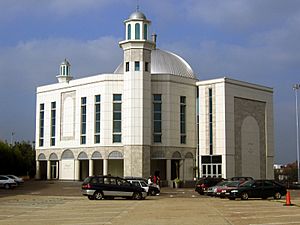
Ahmadi Muslims believe that the Ahmadiyya Caliphate is a continuation of the Rightly Guided Caliphate. They believe it was re-established with Mirza Ghulam Ahmad. Ahmadis believe that God Himself establishes the Caliphate. It is a blessing for those who believe and do good deeds. Therefore, any human effort to create a Caliphate will fail if people are not righteous. They believe God guides believers to choose the Caliph through visions and dreams. No campaigning or speeches are allowed. So, the Caliph is chosen mainly by God, not just by people.
Ahmadis believe a Caliph does not have to be a head of state. His main role is spiritual and religious. He upholds, strengthens, and spreads Islam's teachings. He also maintains high spiritual and moral standards within the global Community. If a Caliph also leads a government, it is a secondary role. The Caliph is also called Amir al-Mu'minin (Leader of the Faithful). The current Caliph is Mirza Masroor Ahmad.
The Consultative Council
The Majlis-ash-Shura (Consultative Council) is the highest body after the Caliphate. The second Caliph, Mirza Basheer-ud-Din Mahmood Ahmad, established it in 1922. This group meets at least once a year. The Caliph leads the international council. Its main job is to advise the Caliph on important matters. These include finances, projects, education, and other issues for Community members. The Caliph is expected to consult with the council. However, he does not have to accept all their advice. He can comment, give instructions, or make decisions. He can also postpone matters for more thought. But usually, the Caliph accepts the majority's advice.
The Headquarters
The main headquarters of the Ahmadiyya Muslim Community is where the Caliph lives. Since the fourth Caliph had to leave Pakistan in 1984, the headquarters was at the Fazl Mosque in London, England. In 2019, the fifth Caliph moved the headquarters to Islamabad, Tilford, England. This land was bought by the Community in 1985.
While Mecca and Medina are holy cities, Qadian is considered the spiritual headquarters. Ahmadis believe the Ahmadiyya Caliphate will return to Qadian, Mirza Ghulam Ahmad's birthplace, in the future. However, the Ahmadiyya city of Rabwah in Pakistan manages most of the organization's activities worldwide. It was founded on September 20, 1948, by the second Caliph after the Partition of India. Rabwah oversees two main bodies: the Central Ahmadiyya Council and the council for 'The New Scheme'.
The Sadr Anjuman Ahmadiyya (Central Ahmadiyya Council) was set up by Mirza Ghulam Ahmad in 1906. Today, it organizes Community activities in India, Pakistan, and Bangladesh. The Anjuman Tehrik-i-Jadid (the council for 'The New Scheme') was set up by the second Caliph. It is responsible for missions outside the Indian subcontinent. Each council has departments like finance, publications, education, and foreign missions. Under the 'New Scheme' council, the Community has built over 15,000 mosques, 500 schools, and 30 hospitals. They have also translated the Quran into over 70 languages. The Anjuman Waqf-i-Jadid (the council for 'The New Dedication') trains religious teachers in rural communities worldwide.
Educational Institutions
One important religious institution is Jāmi’ah al-Ahmadīyya, also called Ahmadiyya University of Theology and Languages. It is an international Islamic school with campuses in Africa, Asia, Europe, and North America. It started in 1906. It is the main place for Ahmadi Muslims to study Islam and train missionaries. Graduates can become missionaries (often called Murrabi, Imam, or Mawlana) or experts in Islamic law. As of 2008, over 1,300 graduates work as missionaries globally.
Youth and Women's Organizations
There are five organizations that support the Ahmadiyya Muslim Community. Each helps with the spiritual and moral training of its members.
- The Lajna Ima’illah is for female members aged 15 and older. It is the largest organization.
- Majlis Khuddamul Ahmadiyya is for male members aged 15 to 40.
- Majlis Ansarullah is for male members aged 40 and older.
- Nasiratul Ahmadiyya is for girls aged 7 to 15.
- Atfalul Ahmadiyya is for boys aged 7 to 15.
Community Structure
The global Ahmadiyya Muslim Community is divided into National Communities. Each National Community has its own headquarters. These are further divided into Regional Communities, and then into Local Communities. Many Local Communities have their own mosque or center. A national president, called Amīr, leads the National Executive Body. This body includes secretaries for finance, preaching, moral training, and education. This structure is repeated at regional and local levels.
Annual Events
Ahmadis celebrate Muslim holidays like Eid al-Fitr and Eid al-Adha. They also have other important events, though these are not religious holidays. The most important event is Jalsa Salana or the Annual Convention. Mirza Ghulam Ahmad started this gathering. Its purpose is to increase religious knowledge and promote harmony among Community members. Other events include "Life of the Holy Prophet Day," "Promised Messiah Day," "Promised Reformer Day," and "Caliphate Day."
Persecution Faced by Ahmadis
Ahmadis have been seen as non-believers by some. The movement has faced violent opposition at times. In 1973, the Organisation of Islamic Cooperation officially stated that Ahmadiyya was not linked to Islam. In Pakistan, the government has officially declared Ahmadis as non-Muslims. The term Qādiānī is often used to insult them in Pakistan.
Ahmadis have faced religious persecution and discrimination since their movement began in 1889.
See also
 In Spanish: Comunidad Ahmadía para niños
In Spanish: Comunidad Ahmadía para niños
- Islamic schools and branches
- List of Ahmadis
- List of Ahmadiyya buildings and structures
- Muslim Television Ahmadiyya International
- Ahmadiyya hospitals
- New religious movement



